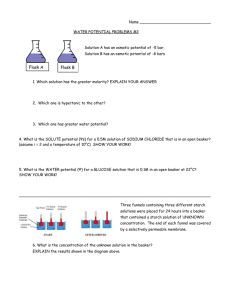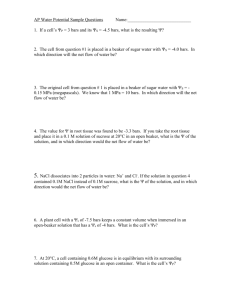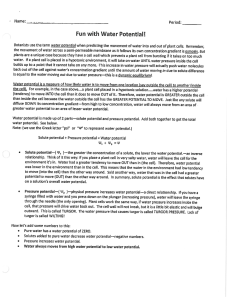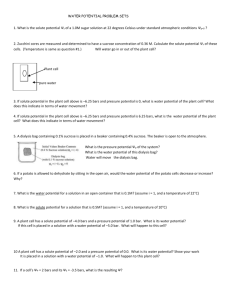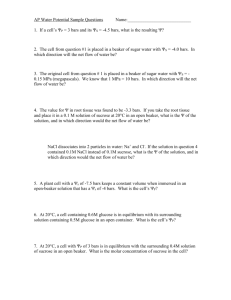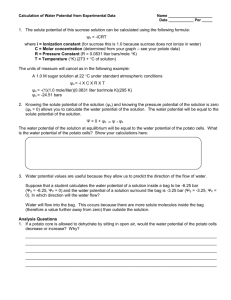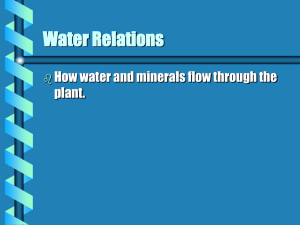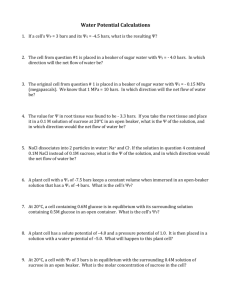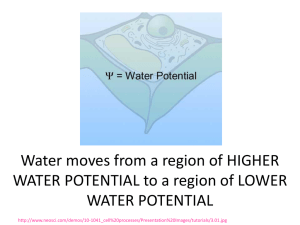Water Potential Worksheet: Plant Cell Biology
advertisement
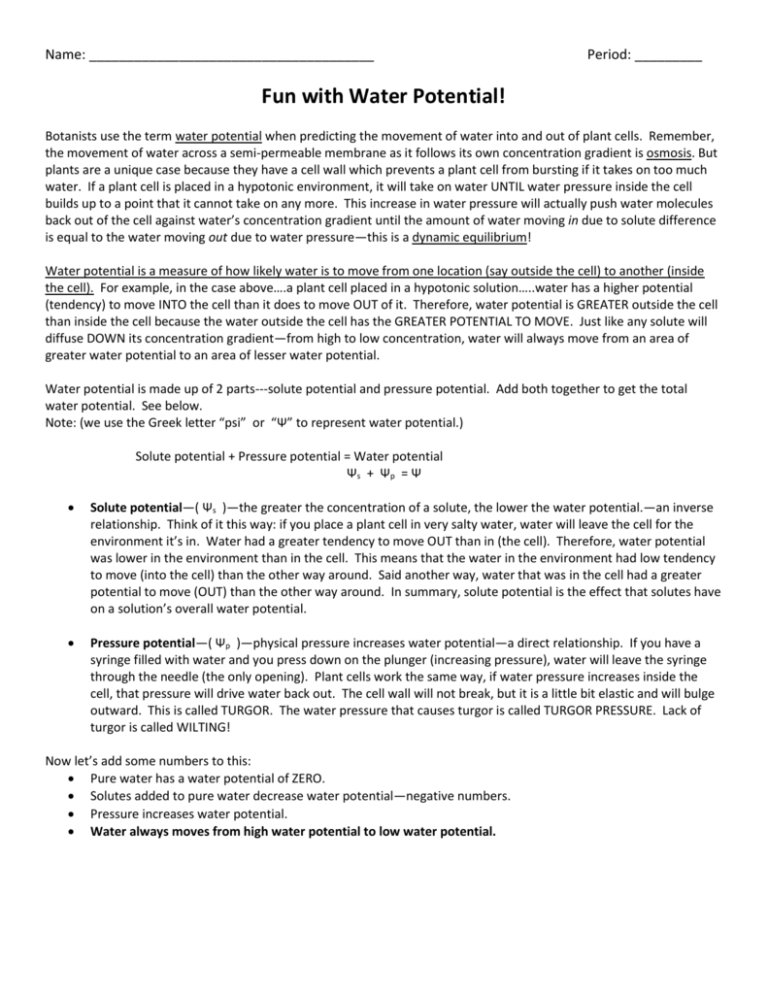
Name: ______________________________________ Period: _________ Fun with Water Potential! Botanists use the term water potential when predicting the movement of water into and out of plant cells. Remember, the movement of water across a semi-permeable membrane as it follows its own concentration gradient is osmosis. But plants are a unique case because they have a cell wall which prevents a plant cell from bursting if it takes on too much water. If a plant cell is placed in a hypotonic environment, it will take on water UNTIL water pressure inside the cell builds up to a point that it cannot take on any more. This increase in water pressure will actually push water molecules back out of the cell against water’s concentration gradient until the amount of water moving in due to solute difference is equal to the water moving out due to water pressure—this is a dynamic equilibrium! Water potential is a measure of how likely water is to move from one location (say outside the cell) to another (inside the cell). For example, in the case above….a plant cell placed in a hypotonic solution…..water has a higher potential (tendency) to move INTO the cell than it does to move OUT of it. Therefore, water potential is GREATER outside the cell than inside the cell because the water outside the cell has the GREATER POTENTIAL TO MOVE. Just like any solute will diffuse DOWN its concentration gradient—from high to low concentration, water will always move from an area of greater water potential to an area of lesser water potential. Water potential is made up of 2 parts---solute potential and pressure potential. Add both together to get the total water potential. See below. Note: (we use the Greek letter “psi” or “Ψ” to represent water potential.) Solute potential + Pressure potential = Water potential Ψs + Ψ p = Ψ Solute potential—( Ψs )—the greater the concentration of a solute, the lower the water potential.—an inverse relationship. Think of it this way: if you place a plant cell in very salty water, water will leave the cell for the environment it’s in. Water had a greater tendency to move OUT than in (the cell). Therefore, water potential was lower in the environment than in the cell. This means that the water in the environment had low tendency to move (into the cell) than the other way around. Said another way, water that was in the cell had a greater potential to move (OUT) than the other way around. In summary, solute potential is the effect that solutes have on a solution’s overall water potential. Pressure potential—( Ψp )—physical pressure increases water potential—a direct relationship. If you have a syringe filled with water and you press down on the plunger (increasing pressure), water will leave the syringe through the needle (the only opening). Plant cells work the same way, if water pressure increases inside the cell, that pressure will drive water back out. The cell wall will not break, but it is a little bit elastic and will bulge outward. This is called TURGOR. The water pressure that causes turgor is called TURGOR PRESSURE. Lack of turgor is called WILTING! Now let’s add some numbers to this: Pure water has a water potential of ZERO. Solutes added to pure water decrease water potential—negative numbers. Pressure increases water potential. Water always moves from high water potential to low water potential. 1. If a cell’s ΨP = 3 bars and its ΨS = -4.5 bars, what is the resulting Ψ? 2. The cell from question #1 is placed in a beaker of sugar water with ΨS = -4.0 bars. In which direction will the net flow of water be? 3. The original cell from question # 1 is placed in a beaker of sugar water with ΨS = -0.15 MPa (megapascals). We know that 1 MPa = 10 bars. In which direction will the net flow of water be? 4. The value for Ψ in root tissue was found to be -3.3 bars. If you take the root tissue and place it in a 0.1 M solution of sucrose at 20°C in an open beaker, what is the Ψ of the solution, and in which direction would the net flow of water be? 5. NaCl dissociates into 2 particles in water: Na+ and Cl-. If the solution in question 4 contained 0.1M NaCl instead of 0.1M sucrose, what is the Ψ of the solution, and in which direction would the net flow of water be? 6. A plant cell with a Ψs of -7.5 bars keeps a constant volume when immersed in an open-beaker solution that has a Ψs of -4 bars. What is the cell’s ΨP? 7. At 20°C, a cell containing 0.6M glucose is in equilibrium with its surrounding solution containing 0.5M glucose in an open container. What is the cell’s ΨP? 8. At 20°C, a cell with ΨP of 3 bars is in equilibrium with the surrounding 0.4M solution of sucrose in an open beaker. What is the molar concentration of sucrose in the cell? 9. You are stranded on a lifeboat with several other people in the middle of the ocean. You have run out of clean drinking water and are very thirsty. The others have started to drink the seawater to quench their thirst. Since you’re waiting for rescue (and are a top notch AP Biology student), you decide to solve a couple of water potential problems to determine if drinking sea water is a good idea or not. a. The majority of dissolved ions in seawater is NaCl, roughly a 0.5M concentration. The ionization constant of NaCl is 2.0. Calculate the solute potential for seawater if you know that the water is 2°C. b. Your own cells have a 0.15M concentration. Calculate the solute potential for your own cells, knowing that body temperature is 37°C. c. Using your knowledge about water potential, if you drink the seawater, wat will happen when the seawater comes into contact with your body’s cells? Note: ΨP for animal cells is zero. d. Is drinking seawater a good idea for survival? What effect will drinking seawater have on you and your chances of surviving until you are rescued?
